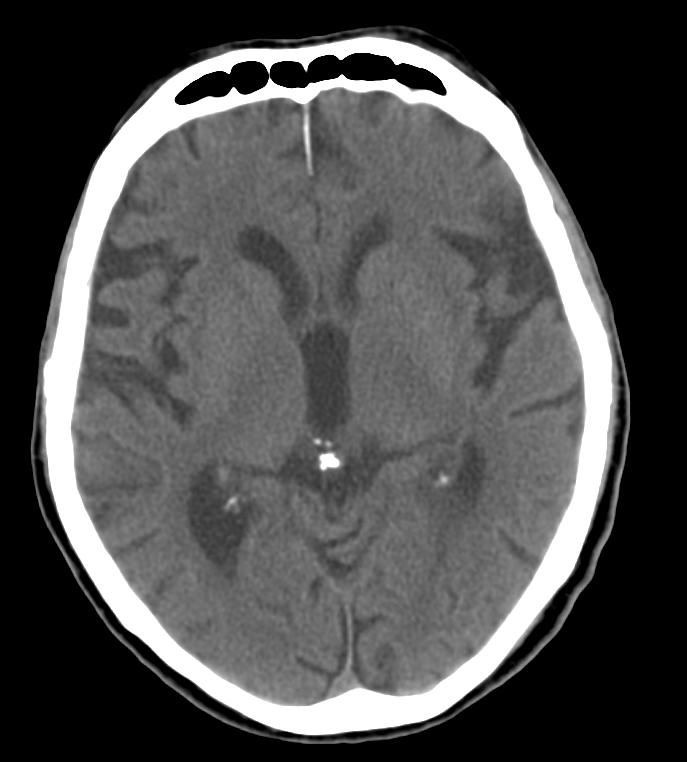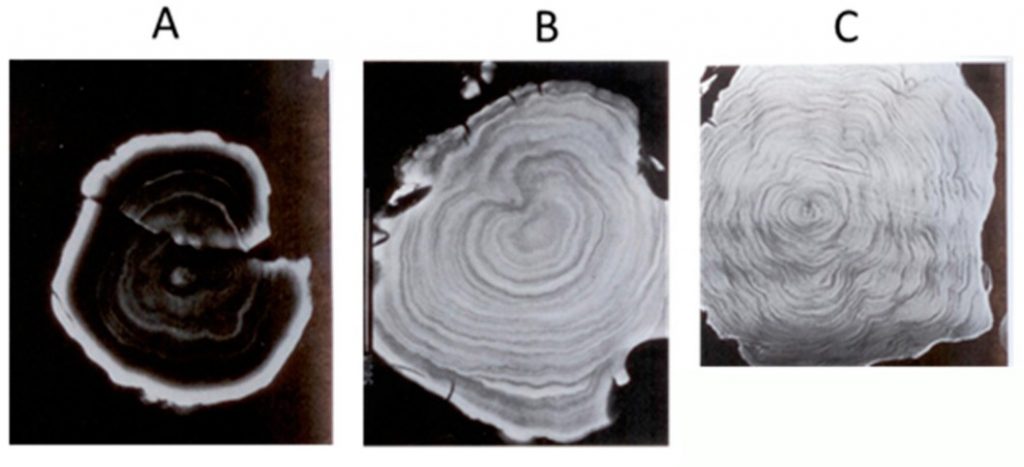What is the Pineal Gland?
The Pineal Gland is a tiny (ranging from one half to one centimetre large) gland near the center of your brain. It has gotten its name from being shaped similar to a pine cone. It’s main function, simply put, is to inform the systems in your body about day and night as well as seasonal cycles by the production and excretion of melatonin into the blood stream. It regulates our sleep-wake-cycle and many other processes. It plays important roles in bone metabolism, regulating body temperature as well as sexual development.
The Pineal Gland used to be a light-sensitive organ in itself, with some species of fish, amphibians and reptiles today still having the so called Parietal Eye. It is a small opening at the top of the skull, usually above or in between the eyes hence often referred to as the “Third Eye”.
The History of Melatonin and the Pineal
Important for vision to function is a molecule called retinaldehyde or retinal. In photosensitive cells of the retina it will bind to rhodopsin and enable a chemical reaction that creates an electrical signal which is forwarded to the brain. During this process the chemical bond will be severed and an inactive form of retinaldehyde will remain within the retina. In a process called “Bleach and Recycle” the inactive retinaldehyde is recycled by an enzyme and then reused for photoreception. However, as long as the retinaldehyde remains in its inactive state, it can potentially bind to arylalkylamines like serotonin and create byproducts that are harmful to the eye. This process will also render the retinaldehyde useless.
Roughly half a billion years ago, supposedly by incorporation of bacterial DNA, animals then evolved the ability to produce enzymes called AANAT and HIOMT. These enzymes can alter arylalkylamines so that they are less likely to bind to retinaldehyde. AANAT processes serotonin into N-acetylserotonin, which in turn will be broken down by HIOMT into Melatonin.
This process left more retinaldehyde avaliable to bind back to rhodopsin and therefore likely improved the low-light vision of our ancestors.
Given these enzymes where mostly active during nighttime, when most retinaldehyde was needed for vision, the highest levels of melatonin were therefore produced at nighttime. Apparently our ancestors adapted to using the presence of melatonin in the blood to sense the time of the day to synchronize bodily functions accordingly.
Given the rising importance of this “timekeeper” in the course of evolution, high levels of serotonin would have been needed within the eyes, which in turn would have compromised vision. This gave rise to the creation of a “third eye”, a light-sensitive cell dedicated solely to the production of melatonin during times of low light.
Because most living vertebrates have a pineal gland, it is assumed that the common ancestor of all vertebrates had two types of light sensitive organs at the top of their heads. As described above they had one type of photocells for vision, and another type for keeping track of circadian and seasonal cycles. This organ further evolved into the Parietal Eye we see in Reptiles and Amphibians. Our cold-blooded cousins need it not only to sense time of day, it is also needed for regulating body-temperature. Once we fully evolved into warm-blooded animals around 300 million years ago, the parietal eye became obsolete and started disappearing. Even though by now our Pineal Glands have evolved to be seated deeply inside of our brains, they are still comprised of cells resembling light-sensitive cells in the retina. It is not fully known through what mechanism the Pineal Gland gathers information about the daylight, because even blind people underlay a relatively normal cycle of melatonin-production. It is possible that dedicated cells within our eyes and pathways in the brain feed this information to the Pineal.
Pineal and Pituitary Gland
Since the Pineal Gland functions as a sort of timekeeping organ, it also controls and regulates many other bodily functions. Melatonin also regulates the function of the pituitary gland, which in itself regulates the secretion of many hormones, mostly related to the reproductive system. Because of this the Pineal Gland is sometimes referred to as the regulator of regulators, giving pace to many vital functions by passing on information about the daytime and season of the year. The Pituitary Gland produces hormones which regulate all of the following functions:
- Growth (via Human Growth Hormone)
- Blood pressure
- Uterine contractions during childbirth
- Breast milk production
- Sex organ functions in both sexes
- Thyroid gland function
- Metabolic conversion of food into energy
- Osmolarity regulation in the body
- Water levels by controlling reabsorbtion of the kidneys
- Temperature regulation
- Pain relief
Many of the bodily functions listed above require a way to keep track of time. This is achieved by the Pineal Gland regulating the function of the Pituitary Gland according to circadian and daily cycles through melatonin. There is also evidence that melatonin plays an important role in timing the onset of puberty.
The Pineal Gland in Humans
The Pineal Gland has been known for more than 2000 years, first described by Greek anatomist Herophilus. He thought that the Pineal was a valve, controlling the flow of subconscious memories from the animal brain into the conscious awareness. Roughly 1900 years later French philosopher, mathematician and scientist René Descartes thought it to be the primary seat of the soul, and where memories are formed.
Nowadays the primary importance of the Pineal Gland is agreed to be the production of melatonin. There are however, a wide number of symptoms and illnesses that can be linked, some more and some less convincingly, to a lack of melatonin production. Next to regulating cycles melatonin has anti-oxidative properties that are protecting the brain from oxidative stress. Consequences of a lack in melatonin can range from neurodegenerative diseases like Alzheimers, sleep disorders, migrane to many other problems indirectly caused by other glands in the body not being properly regulated.
Research by Rick Strassman in the early 90’s first showed that the pineal also produces and regulates production of n,n-dimethyl-tryptamine, widely known as DMT. This Alkaloid is a strong psychedelic substance, possible the strongest there is, not by potency but by subjective severity of the experience. People who have used sufficient doses of DMT regularly describe being taken to a spiritual parallel-world that feels realer than normal reality, contacting spiritual or extraterrestrial beings and indescribable phenomena, while the sense of ego and memory mostly remains fully intact. This research lead to the idea that the Pineal might produce DMT in significant doses during the experience of death, explaining many of the supernatural phenomena experienced by near-death survivors.
Calcification

Since the Pineal Gland secretes melatonin directly into the bloodstream, it is not protected by the blood brain barrier. In fact, it even gets the second-most quantity of bloodflow of any organ next to the kidneys. Because of that it is also susceptible to being impaired by toxins in the blood. Especially harmful to the Pineal are synthetic forms of flouride like hydroflouric acid or sodium flouride (as found in dental products or the water supply of certain countries), cryolite and sulfuryl fluoride (as found in many widely used pesticides), chlorine and lastly calcium carbonate (as found in many calcium-supplements). These chemicals will form crystalline structures in the pineal gland, giving it a hardened shell that can be seen on MRI images.
A certain amount of calcification has historically been present in humans but increased drastically with the use of flouride, pesticides and the like. The strong common calcification in human Pineal Glands is well documented, even though scientists disagree about it’s harmfulness. So decide for yourself if you think you should make an effort to try and get rid of these residual chemicals in your brain.

The pineal gland was found to contain mesenchymal stem cells that can develop into osteablasts as well as osteocytes, cells that are vital for bone formation. This process is as well controlled by the presence of melatonin and can potentially play a role in aging and osteoporosis. The possibility remains, that calcification of the pineal is a natural phenomenon to a certain degree, involving the presence of said osteoblasts and osteaocytes within the gland.
The Pineal in Spirituality and Yoga
The mysterious nature of the pineal gland has created many spiritual believes and assumptions involving the tiny organ. It is said to play in important role in the level of consciousness experienced and be crucial for spiritual development and/or enlightenment. Every person researching this topic should make an effort in discerning fact from fiction and try to get a clear understanding of the role the pineal plays in personal development and wellbeing.
A yogic view on the subject suggests that by the age of approximately 8 the pineal gland starts to calcify and regenerate, therefore insufficiently regulating the pituitary gland. The pituitary therefore becomes overly active in producing sexual hormones, giving birth to our worldly personality, strongly influenced by sex and gratification. In this process we also lose touch with our higher selves.
Just like the Pineal and Pituitary glands work closely together, the same connection is said to be apparent in the third eye and crown chakra. The pineal, represented by the third eye or Ajna chakra, acts as a lock on the pituitary or crown chraka, regulating its function and therefore the experience that lies within it. By decalcifying the pineal gland and activating the third eye we can restore its function and gain access to the life experience of a properly regulated pituitary gland. The third eye can be awakened with various yogic techniques, two simple examples are Trataka and Shambavi Mudra.
Cleansing the Pineal Gland
If you want to decalcify your pineal gland the first thing you should do is to avoid further consumption of calcifying agents. Try to stop using dental products that contain flouride and use a flouride-free toothpaste instead. Depending on the area you live in you might also want to consider buying a water-filter. Try to eat organic fruits and vegetables that have not been treated with chemical pesticides. Also don’t use any calcium-supplements, but instead try to eat a healthy diet that will naturally supply your body with the calcium it needs.
Next to the two yogic techniques mentioned above, there are further practices that can help you energizing your pineal gland and restore its function.
Sun-Gazing
Sungazing is an old technique that, according to scripture, used to be widely known and practiced by people of all cultures and religions. It can have a wide range of positive effects on people that practice it consistently, from calming the mind to improving mood and health. The most important effect however, is the activation of the third eye chakra, and therefore the pineal gland. According to religious scriptures it can even supply the body with a pure form of energy, that has cleansing effects and will reduce your required calorie intake.
Sun Gazing should be practiced within circa one hour of sunrise or sundown, because it is safest for the eyes in that time-frame. Find a spot where you have an unobstructed view of the sun, try to not look through a window and remove your glasses. Ideally if you are outside and it is warm enough, walk barefoot so you have a better connection to the ground. Rest in a comfortable posture and gaze into the light of the sun.
If you are new to sungazing you should begin with 5 to 10 minute sessions, twice a day if possible, and slowly increase duration to up to half an hour. If you can not manage to get out by the time the sun rises or sets, depending on the conditions you can sun-gaze throughout the day as well. Always pay attention to how it is feeling so you don’t run the risk of damaging your eyes. During the winter months and when the weather is cloudy but the sun still visible, you can gaze at the sun through the clouds. Be careful and do not look directly into the sun if the air is clear and the sun stands near its daily peak, also pay special attention during the summer months and when you are located near the equator. In those cases you can benefit from the suns energy if you gaze at it with your eyes closed.

Supplements
Last but not least you can aid the detox process of your pineal gland by the use of supplements and the right nutrition. If possible try staying away from non-organic vegetables and fruit because they have likely been sprayed with pesticides, that also contain fluoride. Grape juice and wine contains higher levels of fluoride than fluoridated water, because of the pesticides that are used on grapes.
Turmeric
Curcumin, the so-to-speak active ingredient in turmeric, is known for having various health benefits. It has anti-inflammatory properties and is a strong anti-oxidant. Research has shown that it may also specifically aid the body in removing floride and other toxins from brain-tissue. In a study conducted on mice, it was shown that the administration of curcumin reduced the concentration of fluoride in the hippocampus.
According to yogic science turmeric is most effective if it enter the bloodstream through the skin. One method of detoxing the pineal is to rub turmeric paste onto your forehead before you go to sleep for at least a week but up to one month, depending on the grade of calcification.
Iodine
Iodine helps removing heavy metals from the body and is also important for thyroid function. Many people in western countries have low levels of iodine because they don’t usually eat as much fish as for instance Asians. So if you don’t have an iodine-rich diet, using a iodine supplement could be worth a try.
Green Vegetables
Generally speaking all green superfoods that contain chlorophyll can help “repairing” your pineal gland. Chlorophyll is structurally identical to hemoglobin, the oxygen-carrying agent in our red blood cells. Chlorophyll can increase oxygen levels in the body and balance out ph-levels, helping to create a alkaline environment.
SOURCES:
“Pineal Gland Evolved To Improve Vision, According To New Theory” by National Institute Of Child Health And Human Development. August 2004
“Age-related differences in the structure of human pineal calcium deposits” Study by H A Schmid, G Raykhtsaum. January 1995
“The hypothermic effect of melatonin on core body temperature” Study by D Dawson, S Gibbon, P Singh. May 1996
“Pineal Calcification, Melatonin Production, Aging, Associated Health Consequences and Rejuvenation of the Pineal Gland” Study by Dun Xian Tan, Bing Xu, Xinjia Zhou, Russel J Reiter. January 2018
“Association of mast cells with calcification in the human pineal gland” by Danuta Maślińska, Milena Laure-Kamionowska, Krzysztof Deręgowski, Sławomir Maśliński. 2010
“Comparative histology of pineal calcification” by B Vígh, A Szél, K Debreceni, Z Fejér, M J Manzano e Silva, I Vígh-Teichmann. July 1998
“Decalcify You Pineal Gland” Article by Scott Jeffrey
“The sixth sense in mammalian forerunners: Variability of the parietal foramen and the evolution of the pineal eye in South African Permo-Triassic eutheriodont therapsids” Study by Benoit, J., Abdala, F., Manger, P.R., and Rubidge, B.S. 2016.
“Kundalini Tantra” by Svami Satyananda Saraswati
“Curcumin attenuates neurotoxicity induced by fluoride: An in vivo evidence” Study by Chhavi Sharma, Pooja Suhalka, Piyu Sukhwal, Neha Jaiswal, and Maheep Bhatnagar. 2015


